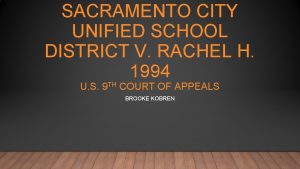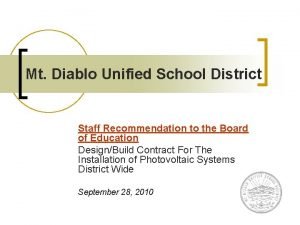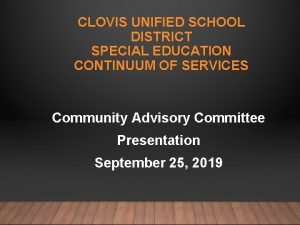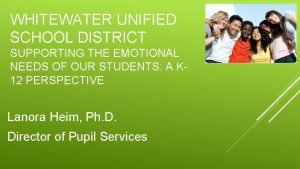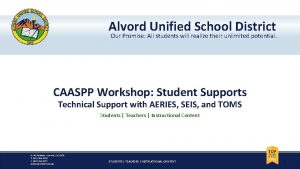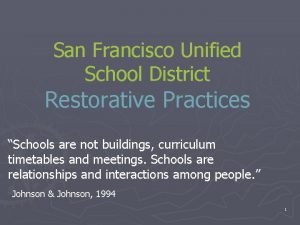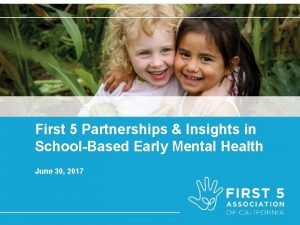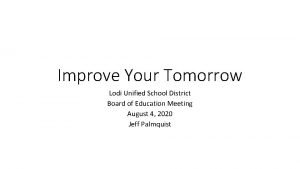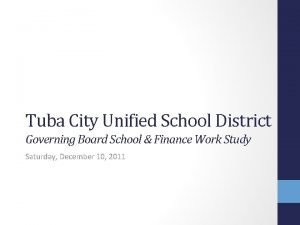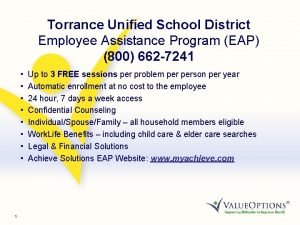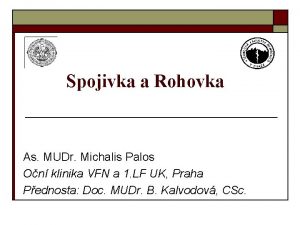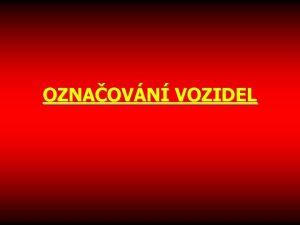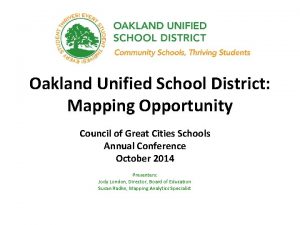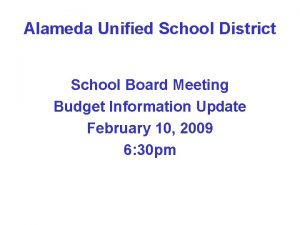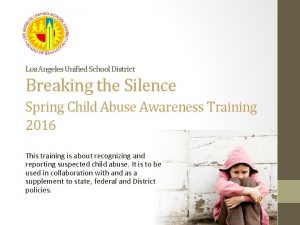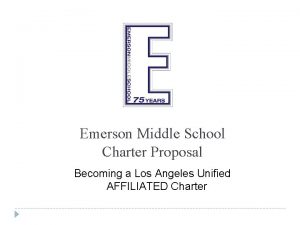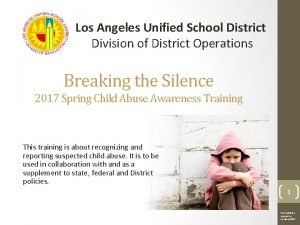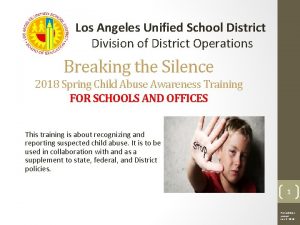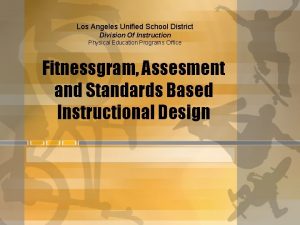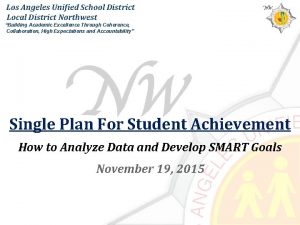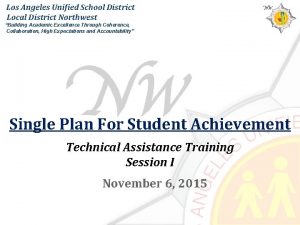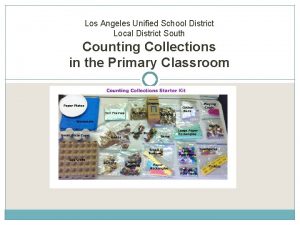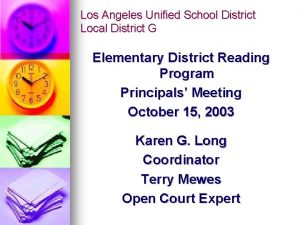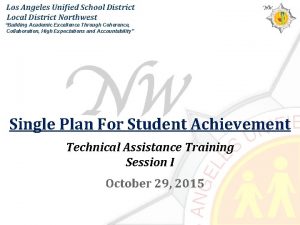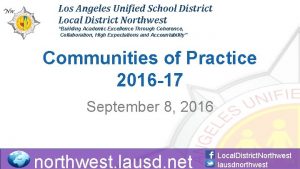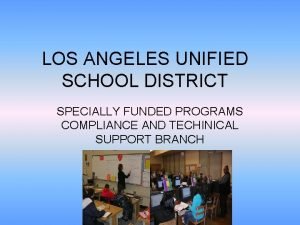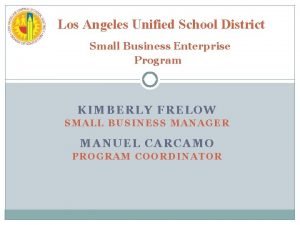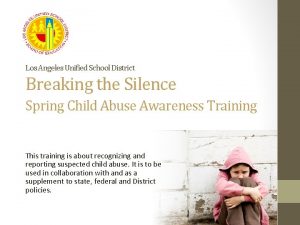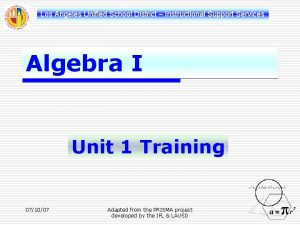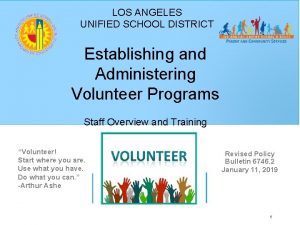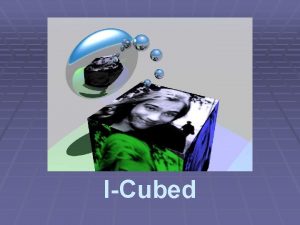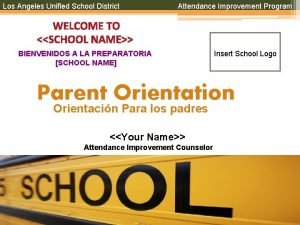Los Angeles Unified School District Division of District





























- Slides: 29

Los Angeles Unified School District Division of District Operations Breaking the Silence 2018 Spring Child Abuse Awareness Training FOR SCHOOLS AND OFFICES This training is about recognizing and reporting suspected child abuse. It is to be used in collaboration with and as a supplement to state, federal, and District policies. 1 Presentation revised Jan. 3, 2018.

Related LAUSD Policies • MEM-6128. 5 Administrator Certification Online System 2017 -2018 For School Sites and Offices (8/7/2017) • BUL-1347. 3 Child Abuse and Neglect Reporting Requirements (8/19/2016) • BUL-0044381. 0 Protocols and Procedures to Report, Reassign and Investigate Allegations of Employee Misconduct (12/22/2017) • BUL-3349. 1 Sexual Harassment Policy (Student-to-Student, Adult-to. Student, and Student-to-Adult) (8/6/2014) • Child Abuse Awareness Training, http: //caat. lausd. net • BUL-4748. 0 Ethics Policies (5/18/2009) • BUL-5688. 2 Social Media Policy for Employees and Associated Persons (9/29/2017) • BUL-5167. 0 Code of Conduct with Students (7/1/2010) All documents listed above are available at http: //caat. lausd. net 2

Reasonable Suspicion For purposes of suspected child abuse/neglect reporting, "reasonable suspicion" means that it is objectively reasonable for a person to entertain a suspicion, based upon facts that could cause a reasonable person in a like position, drawing, when appropriate, on his or her training and experience, to suspect child abuse or neglect. • "Reasonable suspicion" does not require certainty that child abuse or neglect has occurred nor does it require a specific medical indication of child abuse or neglect; any "reasonable suspicion" is sufficient. • Child abuse facts or allegations can be brought to the attention of mandated reporters from any source, including but not limited to: the alleged victim, the alleged victim’s friend, a journal, a colleague, or anonymous source. 3 Reports may be from any source and may be spoken or written.

Child Abuse Definitions • Physical Abuse can be external or internal and includes injuries such as bruises, welts, burns, or cuts inflicted on a child by other than accidental means. Hazing may constitute physical abuse. • Neglect is the failure of a person having the care or custody of a child to provide adequate food, clothing, shelter, medical care, or supervision. Neglect includes a person having the care or custody of a child who willfully causes or permits the person or health of the child to be placed in a situation such that endangers the child. 4

Child Abuse Definitions cont. • Willful Cruelty or Unjustifiable Punishment is any situation where any person willfully causes, inflicts or permits unjustifiable physical pain or mental suffering, or permits the child to be placed in a situation in which the child’s person or health is endangered. • Mental Suffering, Emotional Abuse is mental suffering harm that has been inflicted upon a child and endangers his or her emotional well-being. 5

Child Abuse Definitions cont. • Sexual Abuse includes rape, statutory rape, rape in concert, incest, sodomy, lewd or lascivious acts upon a child, oral copulation, penetration of a genital or anal opening, including the use of any object, touching the genitals or intimate parts or the clothing covering them, or child molestation. • Lewd and lascivious behavior is any unlawful and unwelcomed act committed for the purpose of arousing the libido or sexual interest of the individual or the person towards which this action is directed. • Lewd conduct includes pornography, prostitution, or indecent exposure. • Sexual innuendos may be considered lewd conduct. • Hazing may constitute physical or sexual abuse. 6

Child Abuse Definitions cont. Commercial Sexual Exploitation and Trafficking occurs when a child is treated as a commercial sexual object in exchange for money or something of value. It may also include conduct or encouragement of activities related to pornography. Any minor who is engaged in commercial sexual activity whether as a suspected victim, recruiter, or exploiter, must be reported as a victim of child abuse. Signs that a child is a victim include: • behavior or attire that is not normative for their age • tattoos and brandings of bar codes, symbols of wealth (e. g. , dollar signs, gold coins), and names • frequently runs away from home • frequent absences with suspicious or scripted explanations • has an adult “boyfriend, ” “daddy” or “auntie” with whom the child appears unusually deferential 7

What May Not Be Child Abuse Depending on the circumstance, the following may not be suspected child abuse: • Injuries sustained by accidental means • Parents’ disciplinary actions that are not cruel or excessive and do not result in injury • Physical restraint of child or reasonable force used to prevent a child from harming him/herself or others • School attendance or truancy issues • Incorrigible or poorly behaved students • Fighting between siblings or peers • Homelessness 8

Reporting Guidelines by Age Reportable victims of suspected child abuse include any individual under age 18. • Sexual conduct between consenting parties may or may not constitute child abuse based on the totality of the circumstances. However, under the law, certain conduct between parties requires mandated reporters to report lewd and lascivious conduct or sexual intercourse involving a minor must be reported if the minor is under 14 and the partner is age 14 years or over. Note: Age-appropriate curiosity or sexual exploration between children of similar age may not constitute sexual abuse. • Non-consensual acts of sexual abuse must be reported. In instances of suspected child-on-child sexual abuse, it may be appropriate to report both children as victims of suspected child abuse as many children who perpetrate abuse may themselves be victims of abuse. 9

Mandated Reporters Employees who are mandated reporters include, but are not limited to: • School personnel • Medical personnel • Law enforcement personnel • Counselors • Clergy • Photography and film developers Mandated reporters with reasonable suspicion of child abuse or neglect must: 1. Call an appropriate local law enforcement agency or Department of Children Family Services (DCFS) immediately or as soon as practically possible (for school site reporters, the site administrator should provide class coverage if needed); and 2. Submit the follow-up written report to the agency called within 36 hours of receiving the information. 10

In-Home Abuse vs. Out-of. Home Abuse • CPS agencies (DCFS) are mandated to investigate ‘in-home’ abuse allegations, when the alleged perpetrator is a parent, legal guardian, adult family member in the home, foster parent, group home staff, pre-adoptive, adoptive parent. • DCFS files petitions under WIC 300 (Welfare and Institutions Code) against the parent/legal guardian. • ‘Out-of-Home’ abuse, perpetrator is a stranger, family friend, neighbor, coach, teacher, priest, rabbi, minister, adult boyfriend (and parent is protective), or an LAUSD employee. 11

When making a report, be prepared to provide the following information: • • Child’s Name/DOB Home Address Parent Caregiver Information Sibling Information (if known) Location of the child What happened and why abuse/neglect is suspected When and where the incident occurred **Additional questions will be asked regarding family dynamics; you may or may not know the answers to these questions. 12

Authorized Child Protective Agencies Generally, report out-of-home abuse to law enforcement: • Los Angeles Police Department at 213. 486 -0530 or the local station after hours • Los Angeles Sheriffs’ Department Stations – Please refer to BUL 1347. 3, Attachment A, page 2, for phone numbers in your area. Generally, report in-home abuse to local Child Protective Agencies: • Department of Children and Family Services, (800) 540 -4000 Note: you will only receive a 10 -digit number if a referral is generated. • https: //mandreptla. org/ - electronic follow-up submissions of the written Suspected Child Abuse Reports (SCAR) for mandated reporters Los Angeles School Police is NOT a child protective services agency and CANNOT take reports. 13

Legal Obligations • State law provides immunity from civil or criminal liability for mandated reporters who file suspected child abuse reports. • Failure to comply with mandated reporting requirements may subject an employee to: o professional liability, as well as discipline, demotion, dismissal, and the possible suspension or revocation of credentials, and o personal civil liability which can result in the cost of defense and subsequent related damages the child incurs, if any, and o criminal liability of a misdemeanor punishable by imprisonment in the county jail for a maximum of six months, a fine up to $1, 000, or both. 14

Legal Obligations cont. Under the law, mandated reporters must report all forms of suspected child abuse or neglect, which include: • Sexual abuse • Physical injury or death inflicted by other than accidental means upon a child by another person, • Neglect • The willful harming or injuring of a child or the endangering of the person or health of a child • Unlawful corporal punishment or injury • Serious emotional damage • Commercial sexual exploitation and trafficking 15

Clarify You may clarify to attempt to determine if there is a reasonable suspicion that abuse or neglect has occurred: • Tell me about your drawing. • Tell me about these bruises. • Tell me what happened. NOTE: Clarifying is not investigating. ? ? 16

Do Not Investigate DO NOT corroborate the allegations with witnesses or the accused. DO NOT remove clothing to inspect the underclothing, breast, buttocks or genitalia. • Any indication of abuse observed during a child’s examination may be photographed; however, these photographs may only be given to the child protective agency, along with the report. No removal of clothing to inspect the underclothing, breast, buttocks or genitalia is permitted. DO NOT ask leading questions: • Did your daddy do this to you? • Where else did he touch you? • Did anyone tell you to keep this a secret? ? ? ? 17

What if the Accused Perpetrator is a District Employee? • Mandated Reporters must file the Suspected Child Abuse Report if they have reasonable suspicion of abuse, regardless of who the perpetrator is. • The mandated reporter must advise the employee’s supervisor of the suspected inappropriate conduct to ensure the safety of the children. • The accused may be reassigned during the investigation. • The administrator shall cooperate with the agency in a coordinated manner to investigate the alleged inappropriate conduct. 18

What if the accused perpetrator is a District employee? Cont. • Once the child protective agency or law enforcement has completed its investigation or confirms District officials may initiate their administrative investigation, school site staff should contact their supervisor further guidance (schools should immediately notify their Local District Operations team). 19

Group Discussions 20

This is a Sensitive Subject • We recognize there are various levels of understanding and experience with this topic. Please participate to the extent of your comfort level. • Be mindful of others’ feelings and reactions to the scenarios and discussions. 21

Breakout Sessions Discuss the vignettes in small groups. • At what point do you have a reasonable suspicion of Child Abuse? • What, if any, additional information do you need to determine if reasonable suspicion occurs? • Is there possible employee misconduct (e. g. , sexual harassment, violation of Code of Conduct with Students, violation of Code of Ethics)? • How will you proceed? Who will you notify? Relate each vignette to your school level. • When complete, review recommended responses. ? 22

Large Group Debrief • What items provoked discussion in your group? Why? • What were your challenges? How did you resolve them? • What other conversations occurred in your group? Child abuse and molestation are not always obvious. We hope these activities sparked important conversations on keeping our children safe. 23

Professional Conduct Professional behavior is a priority Consider how behavior can be perceived. Be sure that your behavior is beyond reproach at all times. Maintain appropriate relationships While the District encourages the cultivation of positive relationships with students, employees are reminded that we expect them to use good judgment and are cautioned to avoid any possible or perceived breach of responsible, ethical behavior. 24

Professional Conduct cont. • Be a role model Your responsibility as a professional is to model and teach appropriate boundaries with students and colleagues. • Be conscious of physical contact or touching Appropriate touch is determined by your job setting and duties. Nurses, preschool teachers, and middle school teachers, for example, have different roles and guidelines for appropriate touch. You are responsible for guarding against possible misunderstandings. 25

Recommended Ways to Support Children • Protect by maintaining structure, stability, and consistency • Connect through interaction, activities, and resources • Model caring, compassion and empathy • Teach students to use positive coping strategies 26

Existing Curriculum and Resources to Support Students • Second Step Curriculum and Training is a K-8 classroom-based program that teaches social and emotional skills for violence prevention. It is organized by grade level, teaches children to practice empathy, problem-solving skills, risk assessment, decisionmaking, and goal-setting. • Health Education curriculum K-12. Standards-based lessons cover growth and development with proper identification of body parts, safe and unsafe touch, how to tell an adult if you don’t feel safe, healthy and unhealthy behaviors. • Health Education classes Grades 7 and 9, comprehensive health education standards based instruction in mental, emotional and social health, injury prevention, sexual health. 27

We all have an ethical, moral, and legal obligation to support our children. 28

We are entrusted with the most precious gifts in the world – children! Let’s do our part to keep them safe. 29
 Lodi summer school
Lodi summer school Sacramento city unified school district v. rachel h
Sacramento city unified school district v. rachel h Humboldt unified school district
Humboldt unified school district Abc unified school district
Abc unified school district Medford unified school district
Medford unified school district Abc unified school district
Abc unified school district Clovis unified preschool
Clovis unified preschool Abc unified school district
Abc unified school district Alvord unified school district
Alvord unified school district Sfusd restorative practices
Sfusd restorative practices First 5 alameda
First 5 alameda El segundo unified school district
El segundo unified school district Aeries selma unified
Aeries selma unified Lodi usd board meeting
Lodi usd board meeting Tuba city homicides
Tuba city homicides Torrance unified school district board meeting
Torrance unified school district board meeting Spojivková injekce
Spojivková injekce Abc unified school district
Abc unified school district Oakland unified school district map
Oakland unified school district map Novato school board
Novato school board Moraga breakfast
Moraga breakfast Millbrae unified school district
Millbrae unified school district Qde maple
Qde maple Etiwanda unified school district
Etiwanda unified school district Aeries alvord unified school district
Aeries alvord unified school district Alameda school board meeting
Alameda school board meeting Abc qu
Abc qu Los angeles school
Los angeles school Emerson charter middle school
Emerson charter middle school Las lenguas cesarán
Las lenguas cesarán

